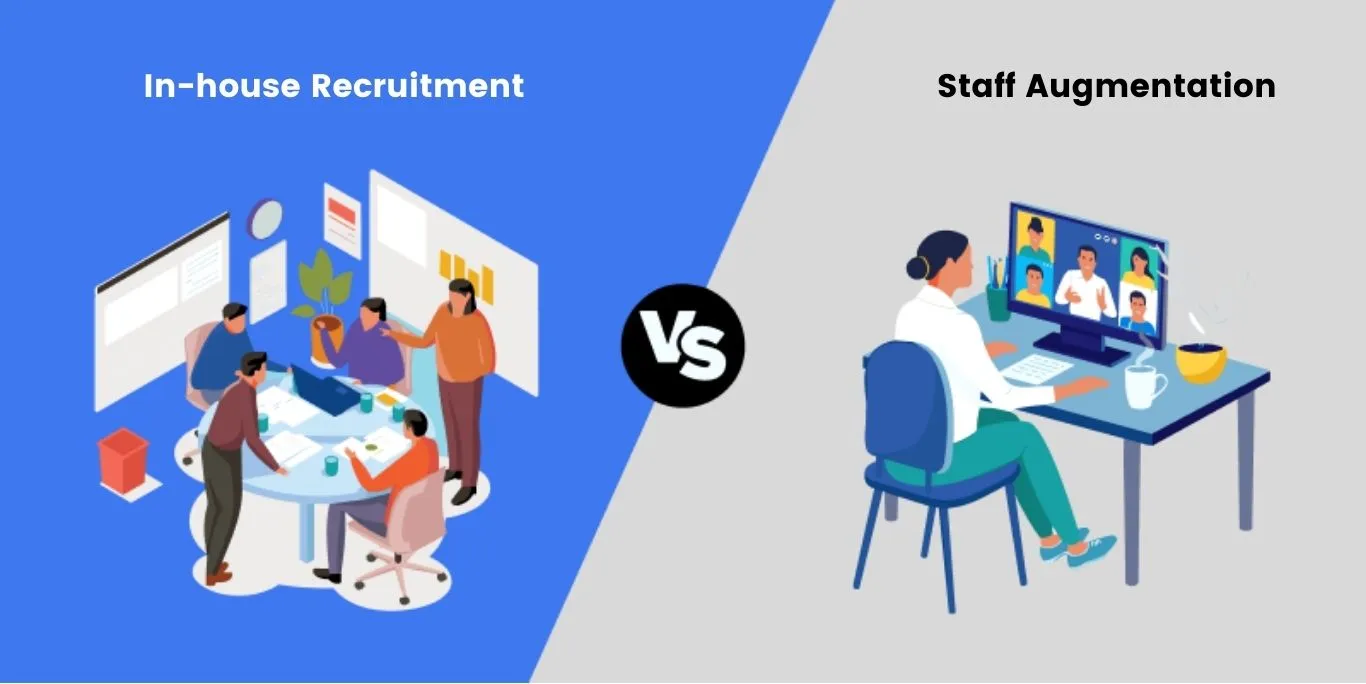As global digitalization is gaining momentum, the demand for professional IT specialists of all kinds grows
exponentially. Now and then companies face challenges with hiring seasoned software developers, DevOps engineers, QA
engineers, data analysts, etc. To fill in gaps in their IT teams businesses consider different staffing models. The most
popular of them are in-house recruitment and staff augmentation. To be honest, in-house vs. outsourcing software
development is an oft-debated subject these days as many business owners beat their brains out to decide which model to
choose. While many aspects affect this decision including approach to management, time frames, security level, etc.,
cost is definitely the most important one. Therefore, to help you make up your mind we would like to shed some light on
the costs associated with both staff augmentation and traditional hiring.

Before delving into the costs associated with the two staffing strategies in question, it would be reasonable to give
definitions to them and outline their key benefits. Let’s start with in-house recruitment as it seems rather clear to
everyone.
In-house recruitment
In-house recruitment is a traditional way to hire specialists using internal resources, i.e. company’s recruiters who
are responsible for all activities needed to fill vacant positions. Thus, they collect job requirements, post jobs
across various resources, screen applicants, and pick up candidates who might check the boxes. After multi-round
interviews, the most suitable specialists get employed and receive wages and fringe benefits that play an important role
in attracting and retaining good employees. A company, in turn, gets committed to employment contracts and local labor
law.
In-house recruitment would not be so popular unless it had significant advantages. Let’s take a look at some of them.
Advantages of In-House Recruitment
Efficient communication. In-house employees traditionally work from an office and an office environment lets them take
advantage of face-to-face communication that is more productive and straightforward compared to one realized via chats
or video and phone calls.
Team building and corporate spirit. In-house employees create a core team, and businesses invest a lot in promoting
corporate values to bring all their employees closer together. Top management and an HR department make efforts to
boost team morale and drive employees’ loyalty and productivity.
Rather painless management. The fact that in-house employees usually work from an office significantly simplifies team
management. Moreover, as a rule, all members of an in-house team live in the same timezone and speak the same
language, which also facilitates easy management.
Better security. As was mentioned, in-house employees work from the office and therefore use corporate hardware and
software which mitigates certain security risks. Additionally, this way companies can more easily track employees’
activities to understand whether they adhere to compulsory security requirements.
Tribe knowledge. In-house recruiters are members of the team, so they know pretty well what specialists and with what
hard and soft skills will be the most suitable. Being aware of corporate policy, the company’s goals, and the
atmosphere within the team, they are able to find the perfect candidate.
Staff Augmentation
Now, let’s turn our attention to staff automation - a modern staffing strategy that has proved itself to be efficient
and has been widely used today, especially in the IT industry. Skype, Slack, Skyscanner, and such giants as Google, IBM,
and Amazon use staff augmentation to increase their capability.
So staff augmentation can be defined as a type of outsourcing suggesting that specialists of an external vendor are
hired to carry out certain tasks on an interim basis. This way companies can fill particular, temporary roles to achieve
their business objectives.
In other words, staff augmentation is a great way to complement an existing in-house team with specific talent,
enhancing its capabilities or filling in skill or knowledge gaps.
If a company has decided to ramp up its team via staff augmentation it applies to an outsourcing company, informs it
what specialists are needed, and submits detailed job requirements. An outsourcing partner screens its talent pool or
looks for suitable candidates on a local market, and finally provides the best fit.
What makes staff augmentation so efficient? Well, to answer this question let’s go through the list of its benefits.
Advantages of Staff Augmentation
Easy hiring process. When it comes to hiring via staff augmentation, you contact an outsourcing company, tell them
details, specify your requirements, and get the result. It requires minimum effort from your recruiting specialists or
relieves your burden even more if you are a startup and do not have recruiters in place.
Time-efficiency. Providers of staff augmentation services have an extensive pool of specialists, so they can instantly
provide you with a suitable candidate who meets all your requirements. Even when it comes to the hard-to-find talent
they have the best recruiters in place with a fine-tuned and efficient workflow that lets them find required
specialists within the shortest possible time.
High flexibility and scalability. We all know that the workload on a project is not stable. If it unexpectedly grows
to the point when your company needs to add some extra specialists, staff augmentation can quickly settle this. In
case you don’t need their services anymore you can quickly lay them off due to not being restricted by employment
contracts or labor law.
Fewer hassles. As long as staff augmentation gives an opportunity to engage specialists without employing them – let’s
say, to rent them – you may not bother yourself with numerous administrative, legal, and organizational issues. Your
outsourcing partner is the one who takes on this responsibility.
Cost saving. Compared to in-house employees, augmented staff costs you less. The staff augmentation pricing model
depends mostly on the rates of your outsourcing partner and the scope of work. More about it can be found in the next
section.
Key Cost Considerations: IT Staff Augmentation vs. In-house Recruitment
Finally, we have got to the fireworks factory! As we know, far too often cost is a determinative factor. Business owners
usually opt for a particular hiring model with regard to an available budget and expected expenses. So we have already
mentioned that staff augmentation is considered to be a more budget-friendly approach. To prove it we would like to
outline the costs associated with each staffing strategy. As long as staff recruitment is just the beginning of the
journey we would like to break down costs on those related to recruitment itself, onboarding, overheads, and staff
retention. Here we go!
Recruitment Costs: In-house Employees vs. Staff Augmentation
| In-house employees | Staff Augmentation |
| Job advertisements | nil |
| HR managers’ wages | |
| Recruitment agency fees | |
| Costs associated with participation in career fairs | |
| Access to professional hiring platforms and job boards | |
| Background checks | |
| Time costs | |
Those who regularly employ new specialists know that the recruitment process is rather pricey. On average, it costs USD
3500-4000 to hire an IT specialist. It includes both direct and indirect costs. Thus, if you have in-house recruiters
you pay them salaries. To enable them to deliver great results as quickly as possible you need to provide them with
access to leading hiring platforms. Moreover, you also face expenses on marketing, advertising, participation in career
events, and others. What is important is that you may also experience time loss because in-house recruitment takes about
2 months on average. As we know, time is the most valuable asset, and procrastination with filling vacant positions can
result in non-evident but significant expenses.
When it comes to staff augmentation, you may forget about all the hassles related to the above-mentioned traditional
recruitment process. You just approach your outsourcing partner, tell them which specialists you need, and receive
profiles of their most suitable candidates. The main thing is that you do not pay a penny for this. Sounds cool, doesn’t
it?
Onboarding Costs: In-house Employees vs. Staff Augmentation
| In-house employees | Staff Augmentation |
| Equipment procurement and setup | nil |
| Workspace maintenance | |
| Office supplies | |
When the perfect candidates are found, you should also provide them with everything they need to work efficiently and
productively. So you should take care about maintaining comfortable workplaces for new hires. It may result in the
necessity to rent a more spacious office. Moreover, you should procure all the needed equipment and provide employees
with the software and tools they need to complete their tasks.
Again, when it comes to staff augmentation, you may not concern yourself with what hardware and software you need to
have in place. Augmented staff work remotely, and an outsourcing company provides them with everything they need to work
on your project. All you need to do is introduce new hires to your in-house team, provide them with instructions, and
grant access to systems and documents they need to use working on your project.
| In-house employees | Staff Augmentation |
| Office rental | Monthly invoices for the provided services including the fee of your outsourcing company. |
| Software licensing fees | |
| Taxes | |
| Wages | |
| Maternity leave | |
| Sick leave | |
| Vacation leave | |
Overheads is the most interesting part of this section. Having an in-house team, you are exposed to numerous ongoing costs related to office rental, taxes, wages, sick leave, vacation leave, parental leave, and others. By the end of the day, you have to pay a significant amount of money every year to maintain your in-house team. As for augmented staff, you pay for the provided services only monthly. Submitted invoices already include the fee of your outsourcing partner that is defined in the contract that you sign with them. No need to say that this sum is noticeably lower than the one you spent for each in-house employee, especially if you partner with an offshore outsourcing company.
Staff Retention Costs: In-house Employees vs. Staff Augmentation
| In-house employees | Staff Augmentation |
| Bonuses | nil |
| Health insurance | |
| Training courses | |
| Team building activities | |
| Catering | |
| Recreation/sports vouchers, etc. | |
These days seasoned IT specialists are rather demanding. Companies have to spend a fortune to keep them engaged. Apart from high salaries they expect to get numerous fringe benefits like health insurance, dental plan, gym membership reimbursement, access to online courses, etc. So if you want to attract brilliant talent and retain them, be ready for significant expenses.
As to staff augmentation, again, your outsourcing company takes care of all this stuff, while you just receive services that you currently need to achieve your goals.
Which approach to choose?
Obviously, the financial aspect is considered to be important. In these terms, staff augmentation is an obvious leader. But it would be wise to take into account other factors that can be indeed critical as well. To help you weigh all the pros and cons and make the right choice, we would also like to highlight use cases in which each staffing strategy is the most relevant.
When Is It Better to Opt for In-house Recruitment?
In-house recruitment is the best choice for those who find themselves in the following situations:
Skill set improvement is needed on a long-term basis;
There are professional in-house recruiters who can cope with all hiring activities;
Your budget lets you maintain an extensive in-house team;
You are not time-constrained and can afford to seek talent as long as needed;
Your company can offer a competitive salary and fringe benefits to attract potential candidates and retain them;
Your company is interested in having its own talent pool.
When Is It Better to Go for Staff Augmentation for Software Development?
A lot of companies may come to the conclusion that staff augmentation is more advantageous for them, especially when it comes to the following use cases:
You have recently set up your business and don’t have an opportunity to maintain extensive in-house teams.
You don’t have an in-house recruitment team and would like to avoid possible fatal errors of hiring the wrong people.
You need to engage a specialist as quickly as possible and on an interim basis.
You are on a tight budget and can’t handle the expenses on benefits, taxes, equipment procurement, and other stuff needed for maintaining a large in-house team.
You are ready to put extra effort into managing remote team members.
Summing Up
Cost is an important factor that can define your choice between different staffing strategies. In these terms, staff augmentation is a clear winner because as you read above in-house employment is associated with high recruitment costs, onboarding costs, ongoing costs, and costs on staff retention and training. On the flip side, staff augmentation is a great way to engage brilliant talent for a needed period of time while paying less. Still, every company and every project is unique. So before making a choice between the most popular staffing strategies – in-house recruitment and staff augmentation – you should meticulously study your needs and assess your capabilities.




